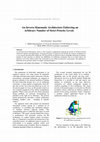Papers by Paolo Baerlocher
Intelligent Robots and Systems, 1998. …, 1998
In this paper we compare two formulations for the kinematic control of redundant manipulators, ba... more In this paper we compare two formulations for the kinematic control of redundant manipulators, based on task prioritization. We also propose an incremental method to speed up the evaluation of the solution. This is especially interesting when dealing with multiple task-priority levels and with highly redundant structures. Finally, the effectiveness of the approach in the context of posture control of human-like articulated figures is illustrated.
Magnenat-Thalma/Handbook of Virtual Humans, 2004
5 Body Motion Control Ronan Boulic, Paolo Baerlocher ... Some authors have explored the poten-tia... more 5 Body Motion Control Ronan Boulic, Paolo Baerlocher ... Some authors have explored the poten-tial of Markov chains and Hidden Markov Models (HMM) to capture and generalize the temporal pattern information for a set of related motions (Molina-Tanco and Hilton 2000). ...
Computer Graphics Forum, 2000
In this paper, we present a new method for solving the Motion Retargeting Problem, by using an in... more In this paper, we present a new method for solving the Motion Retargeting Problem, by using an intermediate skeleton. This allows us to convert movements between hierarchically and geometrically different characters. An Inverse Kinematics engine is then used to enforce Cartesian constraints while staying as close as possible to the captured motion.

The Visual Computer, 2004
An efficient Inverse Kinematics solver is a key element in applications targeting the on-line or ... more An efficient Inverse Kinematics solver is a key element in applications targeting the on-line or off-line postural control of complex articulated figures. In the present paper we progressively describe the strategic components of a very general and robust IK architecture. We then present an efficient recursive algorithm enforcing an arbitrary number of strict priorities to arbitrate the fulfillment of conflicting constraints. Due to its local nature, the moderate cost of the solution allows this architecture to run within an interactive environment. The algorithm is illustrated on the postural control of complex articulated figures. ) ( J N n J N P x J J J I P SVD of J Compute J Update θ constraints met ? Convergence loop 1 2 1 1 x J J x P J x J J N Figure 21: A combined set of constraints involving balance, reach, gaze while holding the umbrella vertically (with four priority levels). i n J J J J I J J I) ( T J J T J J n J J J I X J J J I)) ( ( − − = In the last step, the pseudo-inverse property J J JJ = + is used.











Uploads
Papers by Paolo Baerlocher